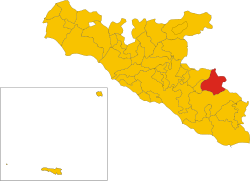Canicattì
| Canicattì | ||
|---|---|---|
| Comune | ||
| Città di Canicattì | ||
 |
||
|
||
 Canicattì within the Province of Agrigento |
||
| Location of Canicattì in Italy | ||
| Coordinates: 37°22′N 13°51′E / 37.367°N 13.850°E | ||
| Country | Italy | |
| Region | Sicily | |
| Province / Metropolitan city | Agrigento (AG) | |
| Government | ||
| • Mayor | Vincenzo Corbo | |
| Area | ||
| • Total | 91.4 km2 (35.3 sq mi) | |
| Elevation | 465 m (1,526 ft) | |
| Population (2016) | ||
| • Total | 35,698 | |
| • Density | 390/km2 (1,000/sq mi) | |
| Demonym(s) | Canicattinesi | |
| Time zone | CET (UTC+1) | |
| • Summer (DST) | CEST (UTC+2) | |
| Postal code | 92024 | |
| Dialing code | 0922 | |
| Website | Official website | |
Canicattì (Italian pronunciation: [kanikatˈti]; Sicilian: Caniattì) is a town and comune (municipality) in the Province of Agrigento in the Italian region Sicily, located about 90 kilometres (56 mi) southeast of Palermo and about 34 kilometres (21 mi) east of Agrigento. In 2016, it had a population of 35,698.
The archaeological remains in the city and in the neighbourhood testify the presence of a settlement before the Roman age. The name of Canicattì is of Arabic origin, from خندق الطين Khandaq al-ṭīn, meaning 'clay ditch'. During the conquest of Sicily by the Normans, the local Muslim lord was besieged and defeated by baron Salvatore Palmeri (1087), a follower of Roger I of Sicily: the latter, as reward, offered him a sword and the lordship over the fief. Under the Palmieri rule the Arab fortress was enlarged, becoming a true castle with a tower.
The Normans were followed by the Hohenstaufen and the French Angevines, in turn ousted by the Aragonese. In 1448 the fief of Canicattì was ceded by Antonio Palmieri, who was heirless, to his nephew Andrea De Crescenzio, who obtained by king John II of Aragon the Licentia populandi, i.e. the permission to enlarge the fief's boundaries, increase its population and administer justice. Under Andrea De Crescenzio Canicattì was a rural community including some 1000/1500 inhabitants, living in the upper part of the town. Andrea De Crescenzio was succeeded by his son Giovanni, who, having no sons, left the barony to his father-in-law Francesco Calogero Bonanno, in 1507.
...
Wikipedia


